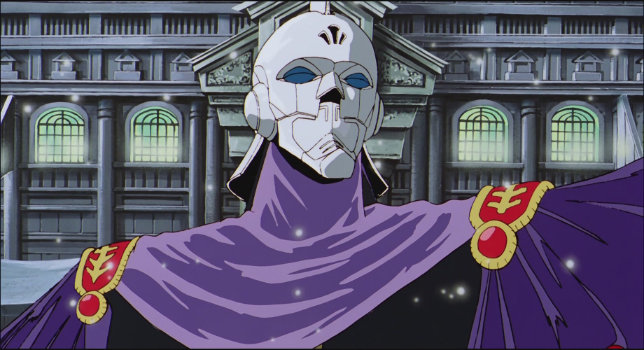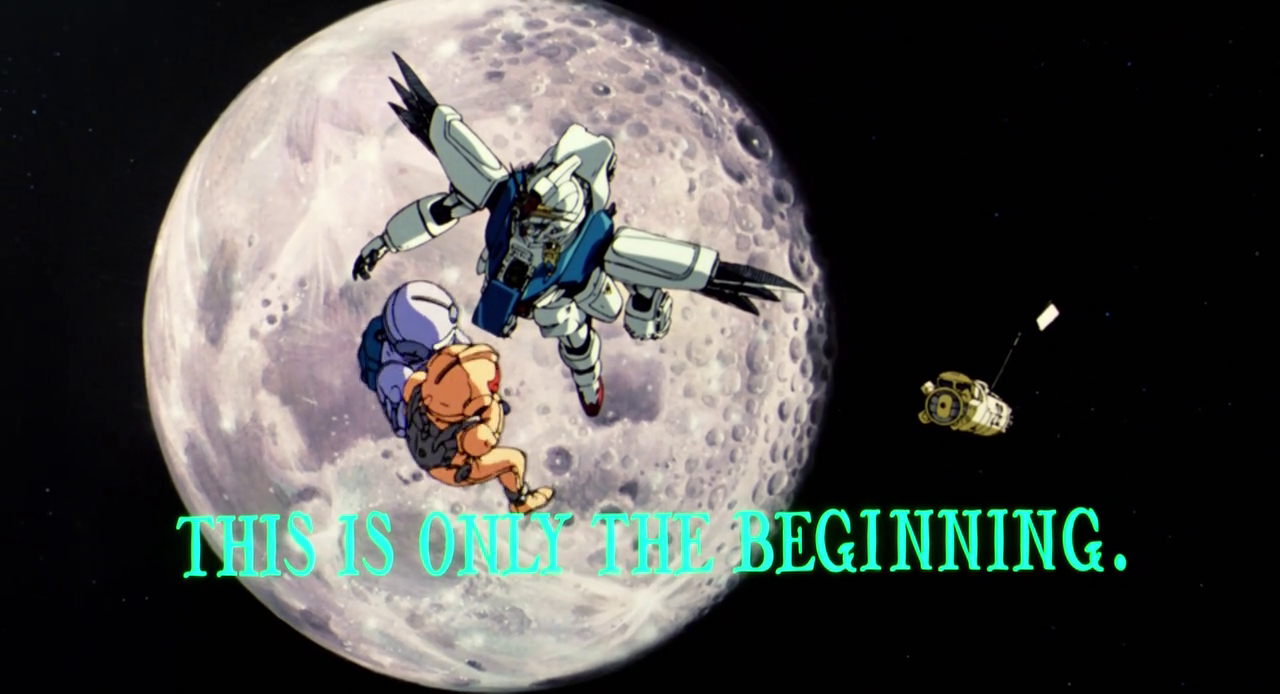Gundam F91, Transhumanism, and Monsters
# 19 Sep 2019 by Sean
Carozzo Ronah, aka Iron Mask
On Tuesday, 10 September, I went to see Gundam F91 with my best (Freedom Fighter) Gunboy Thom, who is one of the hosts of Mobile Suit Breakdown, and Allie, another regular guest on the pod. After the movie we went back to the studio and recorded our thoughts on the movie. In general, we really liked it (at least, we thought it was a masterpiece in comparison to the clusterf*** that was Gundam NT), but in the course of our conversation we stumbled across the monstrousness of the movie’s main villain, and how his being a ‘cyber newtype’ is used to emphasize that.
So, I guess the obvious warning: spoilers for Gundam F91 from here on out. Also there will be spoilers for Mobile Suit Gundam, Mobile Suit Zeta Gundam, Mobile Suit Gundam ZZ (‘double zeta’), Mobile Suit Gundam: Char’s Counterattack, and probably Unicorn and NT.
Before we dive in to the specifics of how F91 talks about Iron Mask’s cyber newtype-ness, we should probably cover what that term means, at least briefly.
In Gundam, there are (often, almost always) folks who have begun to transcend commonly understood human limitations, who are called newtypes. In Japanese, the word used is ニュータプ (Romanized: ‘Nyūtaipu’), which is a neologism, but a neologism using English words1. Newtypes display abilities ranging from precognition to telepathy and intense broadcast empathy, to name a few. One of the recurring plotpoints in the first few series is that the military sees them as the basis of potential super soldiers. Precognition is a useful thing on the battlefield after all.
By Zeta Gundam, we meet characters who are called cyber newtypes in English–artificially enhanced newtypes created to be, you guessed it, super soldiers. But the Japanese word here is not サイバ-ニュウタピ (Romanized: Saiba- nyūtapu) (basically, it doesn’t borrow the phrase “cyber newtype” from English the way the show does for “newtype”). In Japanese, these people are called 強化人間 (Romanized: Kyouka ningen), or “enhanced human” in English.
The first of these people we meet, Rosamia Badam, doesn’t actually display any characteristics we expect of newtypes (precog, ESP, etc), but does have lungs strong enough that she can breathe unassisted at extreme altitudes. So maybe the ‘newtype’ part of the translation isn’t quite right? What is clear though is that she has been engineered to be a better human. She says it, and the other characters around her say it.
It’s also pretty obvious that this unnerves the ‘normal’ soldiers she works with. They are also unnerved by her erratic and emotions and behavior. It becomes clear that the research lab that enhanced her chose her because she would fall in line–she seems to have personal memories of trauma from a recent war that would predispose her to towing the party line (of hating people from space). And the lab didn’t exactly help rehabilitate her emotionally–they’re only interested in enhancing her abilities. Thom and Nina (the other host of MSB), talk about Rosamia’s insecure attachment’ in episode 2.16, which it seems that the military takes advantage of.
But the shows, up through at least Char’s Counterattack (which includes a somewhat healthier cyber newtype who voluntarily went through the procedure and only appears to suffer from ‘normal’ teenage emotional turmoil), to my eye make it clear that the monstrousness of these artificially enhanced humans, whether that is physical or psychic (and there are hints here and there that the process to enhance someone’s mental abilities are… not pleasant) falls entirely on the adults2 who perform these procedures on vulnerable children.
The cyber newtypes themselves are not monsters because they are transhuman. They might (and often) do monstrous things, but that’s nearly always because they have been brainwashed and backed into impossible positions. Much of the hero’s action in ZZ is reaching out to these people and trying to be kind and bring them into the warmth.
In general, Gundam’s stance on transhumanism is pessimistic, but its pessimism lies in its mistrust of the people with power who will have the ability to make others more than human. It does not view the people who undergo the cyber newtype enhancement process as victims of the process, but always as victims of the people who control the process and control access to it.
So this is where I get to Iron Mask in F91. There’s a moment where Cecily (the heroine, his daughter who is rebelling against the family brand of dictatorship) calls him a monster for having had himself enhanced as a cyber newtype (and boy oh boy does this enhancement give him some sweet brain powers).
The movie is structurally a mess (story goes it was reduced from somewhere between a 4-cours TV series or at least an OVA down to a 2-hour movie and they just put… all of it in anyways), but it still works as a narrative and has some fantastic beats. It might even be my second favorite Gundam property. But this moment where Cecily calls Iron Mask a monster felt off to me, and I’ve been thinking about it a lot.
I’m a firm believer in making your body you want to live in, whether that’s through tattoos, piercings, hair color, plastic surgery, prosthetics, hearing aids, canes, those cool glasses that let you see color, implanting magnets in your fingertips so you can do cool techno-magic, taking anti-depressants, meditating, getting swole, eating whatever, microdosing, damn I don’t give a damn. People should get to feel like their body is the one they want to be in. And I’ve always appreciated that Gundam has highlighted that the cyber newtype enhancements are bad only in that they are administered in abusive ways, but themselves have had positive effects for people–a few are able to step outside of the abusive situations they live in by making a psychic connection with someone else.
I think it struck me as off because Gundam has always had such sympathy for the humans who undergo the cyber newtype enhancement process, viewing them as much as victim as aggressor towards the protagonists. But Iron Mask is depicted as straight monster. And, to be clear, he is absolutely a monster, but I don’t think it’s because the enhancement. He is a monster because he commits genocide on a mass scale. He is a monster because he kills people (with his mind!) when they piss him off. He is a monster because he abused his family (subtext not text, but still). He is a monster because he tries to pass himself off as the victim in that family, not the aggressor.
And, I think, he is also a monster because he enhanced himself to get access to better tools to do all of these things more. It’s subtle, but the reason he chose to enhance himself is what makes him a monster to me, not the enhancement itself.
And maybe that’s what Cecily was saying. But it sure as shit didn’t sound like it.
In a movie that I really really love, and love more with each viewing, this one line really sticks like a thorn for me. I wish it had been clearer.

I wish this were true…
-
For an in-depth exploration of the ways in which Japanese invents new Japanese words with English, you should check out the very cool episode of Japan Station about 和製英語 (Romanized: ‘Wasei-eigo’), or Japanese words made from English that are not English words. ↩
-
For Tomino, it seems that ‘adult’ is code for someone who is unable to change their mind and accept new things. And by extension, it is code for people try to enforce their views on others through violence. He has a habit of saying “don’t listen to me, I’m an adult, I’m the enemy” in interviews, which is interesting to me since he’s continued making anime trying to convince people to be better… (maybe he’s not the enemy, or an adult!) ↩
